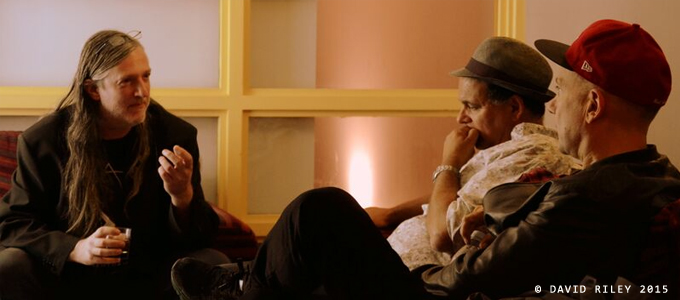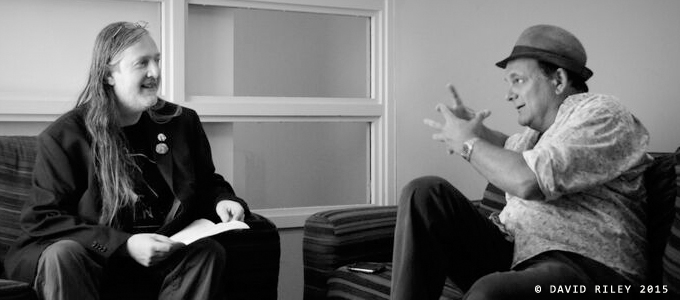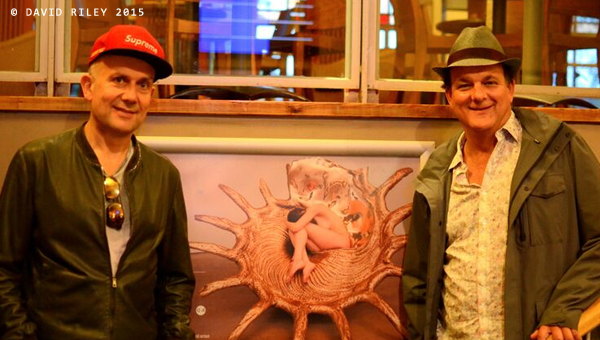 On 23 July the Arts Picturehouse screened MAKING WAVES, a documentary in which Gerry Fox records one year in the life of Marc Quinn. The film delves into the nature of creativity, following Quinn across the globe. Shortly before the post-screening Q&A we spoke to director Fox and subject/artist Quinn about his notorious “shit-head”, his bromance with Fox and the film’s examination of Quinn’s Warhol style “assembly line of art workers”.
On 23 July the Arts Picturehouse screened MAKING WAVES, a documentary in which Gerry Fox records one year in the life of Marc Quinn. The film delves into the nature of creativity, following Quinn across the globe. Shortly before the post-screening Q&A we spoke to director Fox and subject/artist Quinn about his notorious “shit-head”, his bromance with Fox and the film’s examination of Quinn’s Warhol style “assembly line of art workers”.
Anthony Davis: I watched your South Bank Show programme with Marc. Very, very different in style.
Gerry Fox: Completely.
AJD: Was that the sort of Melvyn Braggery of the time, that the artist is a sort of performer? Or was that from you?
GF: No, that was from me. That was the only time that The South Bank Show ever went that far in terms of allowing a director to collaborate with an artist, to create an almost stylised art-film.
AJD: But there were always hints of it, weren’t there ?
GF: Yes, abolutely. I’d done that kind of collaborative thing with other artists: Gilbert and George, Christian Boltanski – people like that, who could play with you. The thing with Marc was to try and make the whole thing a journey through the subconscious. All set in hospitals, because there was that underlying thing in his work…
“At the San Giorgio exhibition, you unfortunately clouted the curator on the head…”
AJD: Turning to MAKING WAVES, it’s obvious that you used a digital SLR?
GF: Yeah, a Canon 5D camera.
AJD: So, the same camera that Marc uses himself?
GF: Yes, exactly.
AJD: It seems to have a lot of manoeuvrability.
GF: Yes, I realised two things about that camera: one, it can give you that lovely, shallow depth of field, so you get a very nice quality of image, and two, because it looks like a [photographic] camera, you get a much more intimate style, because a lot of people think that you’re actually just taking pictures.
AJD: And at the San Giorgio exhibition, you unfortunately clouted the curator on the head… that was an unnecessary level of intimacy.
GF: Yeah, well, it was an accident. I didn’t mean to…
AJD: So, what are the other advantages and disadvantages to using an SLR like that?
GF: Well, you’re more unobtrusive, and you can just go with the flow, but you also don’t need to have a whole crew following you around, so you don’t have to do whole days of filming. You could do half a day here, a half a day there, when things that were interesting were happening. The disadvantages were technical – it’s quite a hard camera to operate on your own. Also, batteries would run out at a key moment, memory-cards would suddenly be full at the wrong time. And the other thing was that you always had to switch on the microphone separately, and there were a few terrible moments with important people like the director of Moma, and you’d be filming away and you’d suddenly look and see that you’d forgotten to turn the microphone on! You normally have a sound engineer who’s concentrating on it, and a camera operator…
“He’d famously made a head, a shit-head.”
AJD: You’ve got to do it all! So you had to keep your wits about you. So, were you and Marc introduced to each other?
GF: We met on another South Bank Show, in which I was very involved as a producer, a few years before that. He’d famously made a head, a shit-head. It became quite a legendary thing on television, nobody’d ever seen that before, so it was quite shocking – and that’s how we first met.
AJD: At the time of the National Portrait Gallery’s acquisition of the previous blood-head, Self, the shit-head was being talked about in an interview with Tim Marlow…
GF: Oh, yeah.

AJD: So, you’ve been friends, then, for fifteen-odd years… ?
GF: Yes. Yeah, we’ve gone on holiday, we’ve done a lot of stuff together … which is unusual, ‘cause I’ve been making South Bank Shows and Channel 4 films for twenty years, but it’s very rare that you become friends with the people you make films about. You tend to move on – the thing that has gelled you together has gone, and your lives separated.
AJD: MAKING WAVES feels a bit like a, sort of, buddy movie…
GF: Yes, we wanted to make it a little entertaining – a rock-and-roll buddy movie, travelling around the world, seeing what the artist does for a living.
AJD: Towards the end of the film, we’ve got that moment where Marc’s splattering the canvas, and gets your shoe – and it’s a very human reaction: “You cunt!”. It’s at that point in the film, those last ten minutes, where you seem to get to some gritty questions…
GF: In the early parts I wanted to be provocateurish, and sort of, tease him and be a bit cheeky, because I wasn’t really sure where this film was going …
AJD: You were looking for an ending… ?
GF: Exactly, but then, in the middle of it, it settled down to be more of an observational film in a way – watching the artist. But, towards the end, I realised that there were questions that people would want to ask – you know, the ‘hand of the artist’ issue – you could see him with all these different people who were making the stuff, these fabricators, and people might want to know ‘Why doesn’t he [do it himself]?’, you know.
“working with Barry Flanagan was like the University of Drinking…”
AJD: So, that’s where those questions found their natural place?
GF: Yeah. I think so, and I think also that it’s better by the end, because, if he’d felt that I was sort of becoming this challenging guy throughout the film, he might have actually called quits on it…
AJD: Did you feel that, Marc?
Marc Quinn: Well, I knew that it would be more of a collaboration… that we were both wanting the same thing, something interesting and new and different. If it had been, like, Gerry asking me some questions all the time…
GF: Yeah, yeah, he may well have called it quits, because, actually, why do you want that… ?
AJD: Good call, on your part, then? You’re on the street in Istanbul, and you’re saying, ‘We’ve done the twelve months’ …
GF: And then, in fact, there’s quite a bit more ! What we realised was that some other things were opening up, so it wasn’t quite the end, but it felt like it, towards it.
AJD: So, Marc, were you a sort of typical Oxbridge entrant, a pretty good all-rounder?
MQ: I was interested in art. I came [to Robinson College in Cambridge] because I was at school, did the entrance exams, and kinda got in…
AJD: But you’ve also got a facility with machinery and technology, and then you end up with this route to where you are now working with Barry Flanagan ?
MQ: Not really – I just said to Gerry earlier, me working with Barry was like the University of Drinking, rather than…
AJD: So you wouldn’t say that there was really anything from his artistic practice that… ?
MQ: Not really, but then, I guess, it was an introduction to ‘the art world’ because I didn’t know the art world, I didn’t know living… artists existed. You know, that you could actually become an artist, earning a living…
AJD: So you weren’t seeking that… ?
MQ: I was, but I didn’t know it – I didn’t know anything about it.
AJD: There’s a point towards the end of the film when Gerry perhaps challenges you a bit more –
MQ: I don’t think it’s a challenge, really – he just asks me questions, which I’m very happy to answer.
AJD: But more so than earlier!
GF: I didn’t really want to be a sort of a Yentob or a Bragg kind of person; it was supposed to be more of a film. But I just felt, towards the end, that there were some unanswered things that we wanted to draw out, and we didn’t want the audience left going ‘Well, why didn’t he answer that?’.
AJD: One of the nice aspects of the film is… hearing you talk about your work in an informal way. We start on the seashore…
MQ: A head to head… Yeah.
AJD: And we come back to the seashore…
MQ: Exactly. Yeah – I was thinking that…
AJD: I went down to White Cube and saw the show there, which was great. That middle chamber, with that just one huge shell.
“He’s famous for his squeegee —”
MQ: Well, you saw me in the film, picking up the thing. And it’s that big, and then it becomes that …
GF: Vast sculpture!
MQ: Yeah.
AJD: I mean, that must be pretty exciting. Is that what keeps you going with art?
MQ: Yes, to go from, just… walking along, picking up something, and thinking about it, and then having the ability… to just actually make it happen, it’s kind of, quite magical.
AJD: Gerry’s just picked up the Gerhard Richter film –
MQ: Did Gerry make it ?
GF: No, not the one I made.
AJD: The film attempts to catch him at his work, and yet it interferes with the process. He’s famous for his squeegee —
GF: Well, he keeps messing them up – it’s awful! He ruins them all! It’s quite sad…
MQ: You say that the film altered his process, self-consciousness… ?
AJD: At the time, he had to say ‘I’ve agreed to this, but I can’t do it’. And we have a little hint of that with you [Marc], when you were doing the Mandela finger-print. You said, ‘I was so busy talking to you [Gerry], I’ve fucked it up’.
GF: I’ll tell you, though, what the difference is between the Richter film and MAKING WAVES is that the Richter film just focuses on one aspect of his work; whereas MAKING WAVES is not only a portrait of the artist, but you also get a sense of the huge range of work that he does.
httpvh://youtu.be/NM8CjoU0fpo

